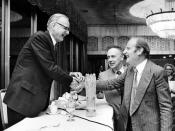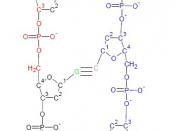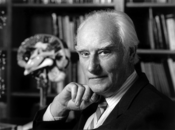Biology 100, section 1, Summer Term 1996
The Double Helix
A review of Watson, James D. The Double Helix. New York: Atheneum, 1968. James Watson's account of the events that led to the discovery of the structure of deoxyribose nucleic acid (DNA) is a very witty narrative, and shines light on the nature of scientists. Watson describes the many key events that led to the eventual discovery of the structure of DNA in a scientific manner, while including many experiences in his life that happened at the same time which really have no great significant impact on the discovery of the DNA structure.
The Double Helix begins with a brief description of some of the individuals that played a significant role in the discovery of DNA structure. Francis Crick is the one individual that may have influenced Watson the most in the discovery. Crick seemed to be a loud and out spoken man.
He never was afraid to express his opinion or suggestions to others. Watson appreciated Crick for this outspoken nature, while others could not bear Crick because of this nature. Maurice Wilkins was a much calmer and quieter man that worked in London at King's College. Wilkins was the initial person that excited Watson on DNA research. Wilkins had an assistant, Rosalind Franklin (also known as Rosy). Initially, Wilkins thought that Rosy was supposed to be his assistant in researching the structure of DNA because of her expertise in crystallography; however, Rosy did not want to be thought of as anybody's assistant and let her feelings be known to others. Throughout the book there is a drama between Wilkins and Rosy, a drama for the struggle of power between the two.
Watson's 'adventure' begins when he receives a grant to leave the United States and go to...


